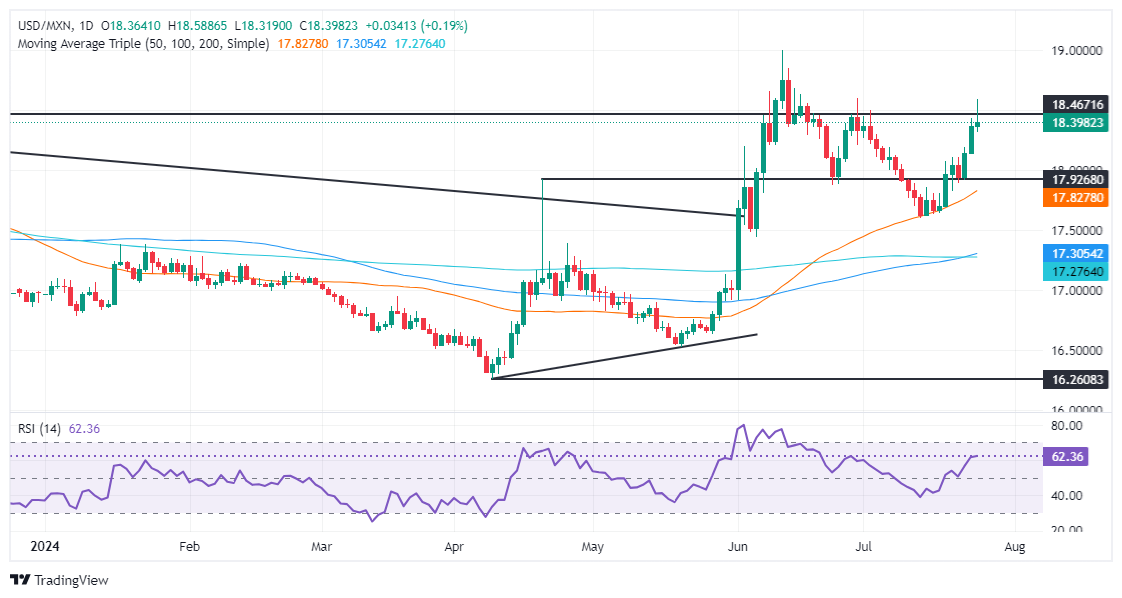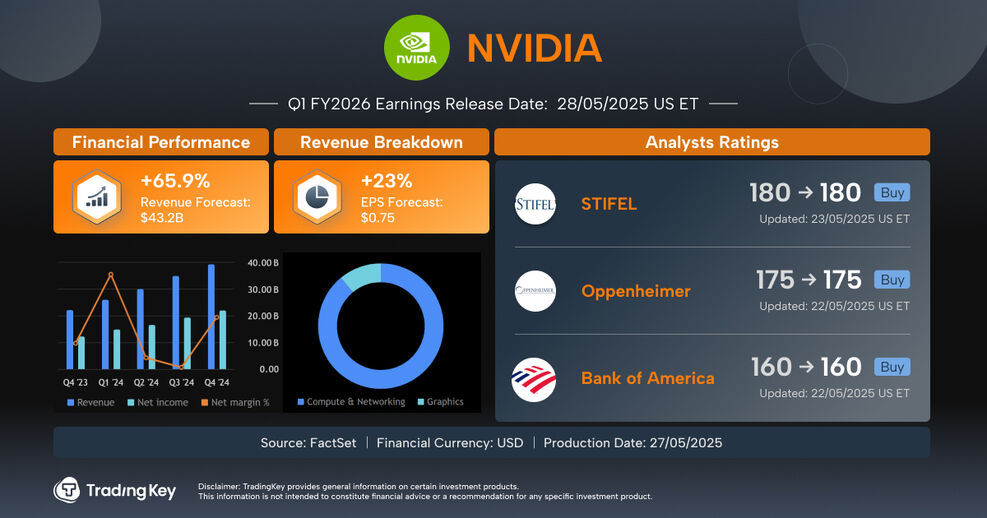- Mexican Peso slips over 0.40% recovering from a six-week low.
- US GDP data for Q2 2024 surpasses expectations, a headwind for the US Dollar.
- Concerns rise over Mexico’s judiciary reforms and Tesla's investment threats due to political uncertainties.
The Mexican Peso recovered some ground and trimmed some of its earlier losses, which pushed the emerging market currency to its lowest level in six weeks against the Greenback. Better-than-expected data in the United States (US) was cheered by investors, who ditched safe-haven assets. Therefore, the USD/MXN trades at 18.43, up 0.47%, after hitting a low of 18.31.
The latest inflation report in Mexico was mixed. Underlying prices decelerated towards the Bank of Mexico (Banxico) goal of 3% plus or minus 1% band, while headline inflation edged above the 5% threshold.
Nevertheless, the report was overshadowed by concerns around judiciary reforms supported by the incumbent President Claudia Sheinbaum, which can potentially impact the emerging market currency. This and threats that Tesla might refrain from investing in Mexico if Donald Trump wins the election on November 5 hurts the country’s nearshoring prospects.
ING mentioned that traders are unwinding high-yielding currencies, particularly against the Japanese Yen, as the Bank of Japan (BoJ) prepares for another rate hike next week. They said, “... markets appear to be unwinding positions in some selected high yielding currencies like MXN and ZAR, while the funding JPY continues to perform very well.”
Aside from this, the US economy is gathering pace as Gross Domestic Product (GDP) crushed estimates in the second quarter of 2024. Other data reinforced the strength of the economy as the number of Americans filing for unemployment benefits missed the mark and was lower than the previous reading.
In the meantime, Durable Goods Orders tanked, though excluding transportation, expanded.
Daily digest market movers: Mexican Peso depreciates amid weaker US Dollar
- Mexico’s mid-month inflation for July jumped by 0.71% MoM, well above the expected 0.39% and the previous 0.21%. Annually, prices rose 5.61%, beating forecasts of 5.27% and last year's 4.78%. Core inflation, excluding volatile items, increased by 0.18% MoM, slightly above the previous month but below expectations. Core prices eased from 4.17% to 4.02% YoY, as predicted.
- According to Citi Research, analysts now estimate that annual inflation will end at 4.30%, up from the previous forecast of 4.20%, with core inflation expected to finish 2024 at 4.0%. Mexico's economic growth is projected to slow, with an expected growth rate of 1.9%, down from 2.0% in the last poll.
- The US Dollar Index (DXY), which tracks the buck’s value against the other six currencies, drops 0.04% to 104.29.
- US GDP for Q2 2024 jumped from 1.4% to 2.8% QoQ, exceeding forecasts of 2% on its advance reading.
- US Initial Jobless Claims for the week ending July 20 rose by 235K, less than estimates of 238K and the prior’s number of 245K.
- US Durable Goods orders plummeted -6.6% MoM in June, well below estimated 0.3%. Core Durable Goods, which excludes aircraft, expanded by 0.5% MoM, up from -0.1% and above consensus projections of 0.2%.
- The CME FedWatch Tools show that the chances of a quarter-percentage-rate cut to the federal funds rate in September are 100%.
- Data by the Chicago Board of Trade (CBOT) shows that traders are pricing in 53 basis points (bps) of easing towards the end of the year, as shown by the December 2024 fed funds rate futures contract.
Technical analysis: Mexican Peso on the defensive as USD/MXN says above 18.30
The uptrend is set to continue once the USD/MXN cleared the daily Simple Moving Averages (SMA) and reclaimed the 18.00 psychological level. Buyers continued to gain traction as depicted by the Relative Strength Index (RSI), which is bullish and with space before turning overbought.
If the USD/MXN decisively breaks the 18.50 figure, the next stop would be the year-to-date (YTD) high at 18.99. A breach of the latter will expose the March 20, 2023, peak at 19.23 before challenging 19.50.
Conversely, if USD/MXN retreated beneath 18.00, that would pave the way to challenge the 50-day Simple Moving Average (SMA) at 17.74, the first support level. The next support would be the latest cycle low of 17.58; the July 12 high turned support. A breach of the latter will expose the January 23 peak at 17.38.

Banxico FAQs
The Bank of Mexico, also known as Banxico, is the country’s central bank. Its mission is to preserve the value of Mexico’s currency, the Mexican Peso (MXN), and to set the monetary policy. To this end, its main objective is to maintain low and stable inflation within target levels – at or close to its target of 3%, the midpoint in a tolerance band of between 2% and 4%.
The main tool of the Banxico to guide monetary policy is by setting interest rates. When inflation is above target, the bank will attempt to tame it by raising rates, making it more expensive for households and businesses to borrow money and thus cooling the economy. Higher interest rates are generally positive for the Mexican Peso (MXN) as they lead to higher yields, making the country a more attractive place for investors. On the contrary, lower interest rates tend to weaken MXN. The rate differential with the USD, or how the Banxico is expected to set interest rates compared with the US Federal Reserve (Fed), is a key factor.
Banxico meets eight times a year, and its monetary policy is greatly influenced by decisions of the US Federal Reserve (Fed). Therefore, the central bank’s decision-making committee usually gathers a week after the Fed. In doing so, Banxico reacts and sometimes anticipates monetary policy measures set by the Federal Reserve. For example, after the Covid-19 pandemic, before the Fed raised rates, Banxico did it first in an attempt to diminish the chances of a substantial depreciation of the Mexican Peso (MXN) and to prevent capital outflows that could destabilize the country.






